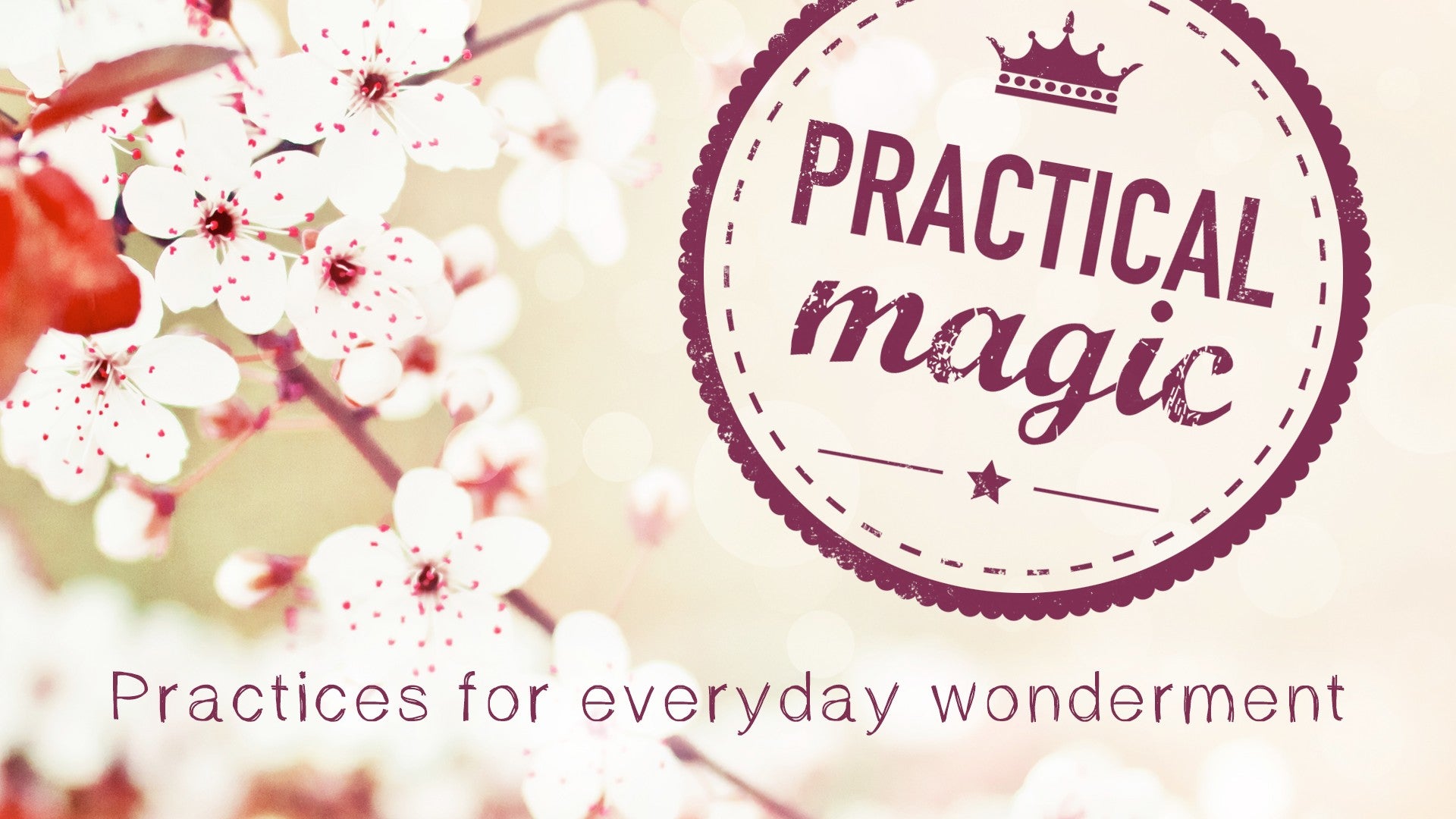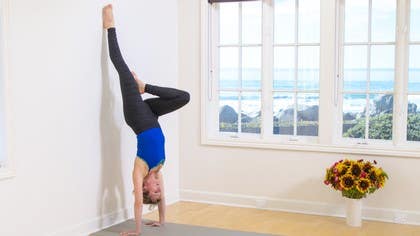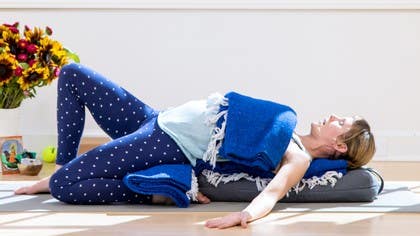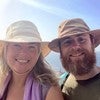Description
About This Video
Transcript
Read Full Transcript
Hi. I'm glad you're here. For this practice, we'll begin in a little wild. And we'll be working with some shapes that are a little more complicated architecturally. And whenever we move into this kind of work, I like to take a little time at the beginning to talk about what it is that we're doing here in this practice of yoga. And, of course, that is an intensely personal question that I think you should revisit from time to time. You might ask yourself, why am I doing this? And is my practice moving me toward that purpose? So within that, let's look at how effort and engagement relates. There can be a temptation to push ourselves so hard and to get bogged down in achieving the pose. And this is totally normal. This is a totally human response to the work that we're doing here. And so if you're feeling like that, like when the rest of your class is moving in toward a shape and you're worried about hitting that mark, you're normal. I do it too. But whenever it occurs to you, can we come back to some of these ideas that are fundamental in our practice and fundamental in our body? Take the breath, for example. The inhalation is the path of action. The exhalation is the path of renunciation. Now, in the yoga sutras, these two concepts are referred to as abhyasa, showing up, doing the work, practicing for many moons, and vairagya, without attachment to any result. If you've tuned into some of the Bhagavad Gita videos that we've had here, if you're familiar with any of that work, you've got action on one hand without attachment to the fruits of the action on the other. So my prayer for you and for myself as we're working through these is to remember the renunciation, to remember the vairagya, the practice without attachment to the results. And if it's possible to even as we're in the heat of the moment, even as we're in that intensity moving toward the fullness of the moon, can there be a little release embedded in there? So that's the idea. And I'm glad you're here. The essence of this practice is that we are wild and serene all at once. And this actually comes from something I read in the Radiance sutras by Lauren Rochet where he talks about lightning and saying there's a passage that says, nature is wild and serene and so am I. Thanks for being here. We'll begin standing in a somewhat wide-legged stance. Turn the toes out ever so slightly. And as always, if something feels like it's not working or it's not stable, change it up. Test and change. And so we'll begin with a full breath in and an easy breath out. A couple more just like that. Just feeling the connection to the earth. Feeling the connection to the sky. And we'll take another breath in. And as you exhale, we'll start to slide the hands down the legs as you bend the knees folding into a forward fold, releasing the head last. And as you breathe in, roll up slowly. This feels sort of like flash dance to me. Exhale, bending, sliding the hands down, releasing the head last. Inhale, rolling up. Add your own flare, please. Exhale. Inhale, rolling up. And let's do one more just like that. Exhale, sliding the hands down the legs. Reusing the head. Inhale, rolling back up. And this time we're going to change it ever so slightly. As you inhale, sweep arms, hands, and fingers toward the sky. And as you exhale, bring the hands to the heart. Again, as you breathe in, sweep arms, hands, and fingers to the sky. Exhale, hands together at the heart. One more just like that. Inhale. And exhale. And from here, we'll start the same way. Inhale, sweeping arms, hands, and fingers toward the sky. And as you exhale, as you bring the hands to the heart, we'll start to bend the knees as well, coming to horse. And horses, particularly female horses, are this very fascinating and subversive character throughout history, particularly in the Indian subcontinent. So while you're here, see if you can embody that wildness and serenity of a horse. You're pressing your feet into the floor. Tailbone is dropped. Let the pelvis be a little watery here. Soft shoulders. Connect with the electricity of your skin. As you breathe in the next time, press the feet into the floor. Rise up to stand. And as you exhale, release the arms down. Now you might widen the feet just the teeniest, tiniest little bit. And on an inhalation, sweep arms, hands, and fingers toward the sky. Press the feet into the floor. And as you exhale, hinge from the hips, folding forward.
So toes are out. This can be a little challenging balance-wise. So if you feel like you're going to fall over, you're not alone. At the pace of your own breath here, we'll inhale and lift the heart, lengthen the spine. And as you exhale, we'll start to bend the left knee, shifting the hips toward the left, maybe looking right. We'll inhale, come back to center. Lift and lengthen. And exhale, bend the right knee, shift the hips toward the right, maybe look left. And we'll do this at the pace of your own breath, moving just like you, feeling your way into it, letting go of the idea that it needs to look a certain way and let yourself sort of feel into it. And when we do that, when we release some of the expectations, we give things an opportunity to be more wonderful than we ever could have imagined. Okay, these last couple, let's really get weird. Let yourself just do what feels right. Last one. We'll exhale back to the center. And as you exhale, we'll turn the feet so that the toes are facing the long side of the mat, fairly parallel to each other. And we'll feel our way into hammock pose. Walk the fingertips forward, send the hips back, let the heart sag. One of the things that we have done in yoga classes over the past however many years is we've reclaimed the word sag. It's a positive thing. Do it with relish. As you take your next breath in, we'll walk the hands a handprint closer to your body, lift the heart length and the spine and we'll start to walk over toward the left, turning the left toes to face the short side of the mat, spinning onto the ball of the right foot into a runner's lunge. Breathe into the length of your beautiful form. And as you exhale, we'll lower the right knee to the floor and let's untuck the toes. Maintain a sense of some stability there by engaging at the glutes. And then we'll kind of climb out, bring the hands to the top of the left thigh and let yourself sort of sink into the pelvis here. Tailbone is heavy. Heart is light. Belly engaged just enough. Now let's feel for that length of the right side of the body. On an inhalation, sweep arms, hands and fingers toward the sky. Reach through the fingertips and exhale, soften. Can you be with this length, this electricity of the front of the body and the softness, the sweetness, the openness of the back of the body? Tucking the right toes under. As you inhale, reach arms, hands and fingers forward. Lift the right knee away from the floor and we'll spin back so that we're facing the long side of the mat. Bring the hands right under the shoulders, lift the heart, lengthen the spine, and this time we'll sag or we'll fold into Prasadipadottanasana. Heart moves toward earth, chin tucks ever so slightly. The hands might walk back. And with every breath cycle, can you be with that path of action, path of engagement, path of renunciation? Showing up, doing my part and then trusting. Abhyasa Vairagya. Now from here, we'll start to meander over to the right side. So we'll turn the right toes back toward the right side of the mat, walk the hands around, spin onto the left ball of the foot and extend into your runner's lunge. Breathe into the length of the back of the body, the front of the body. And on an exhalation, lower the left knee down to the floor, untuck the toes, but maintain a sense of stability by engaging that left glute. I know all of you are thinking like, that lady loves to grab her own butt. It's true. And we'll kind of climb out of here. Heart blooms, tailbone, attentive to the gravity that's already happening. Notice my glutes are firing. Inhale, sweep arms, hands and fingers toward the sky. Lift and lengthen. And then exhale and soften. Be attentive to the skin and the contact that the skin is making with sky and that the skin is making with earth. As you inhale, reach hands, fingers down to the floor, tuck the left toes under, lift the knee, spiral back around and we'll settle again into a juicy forward fold here. Either hammock or prosciutto, whatever feels best, maybe sending the hips back. Bring the hands right beneath the shoulders. As you inhale, lift the heart length in the spine. We'll start to walk over to the left again. This time we'll just pause here before stepping back into downward facing dog. And take your time in downward dog to like feel around for the edges of the container that we refer to as the shape. So you might find yourself like really moving so far that you know where downward facing dog stops being downward facing dog. And from here we're going to get a little watery. We're going to sort of transition from dog to plank using the heels and letting that action sort of ripple through the entire body. So you might lift the heels and let that sort of domino through the body, head shifts forward, heels bring you back. Lifting, shifting, returning. Lifting, shifting, returning. One more just like that, lifting, shifting, returning. And this time we'll lift, we'll shift and we'll stay in this sort of booty lifted plank for a moment.
Engage the serratus anterior by drawing the triceps toward the back of the mat. And from here we'll step the feet back so that you're in regular old fashioned plank. And on an exhalation, lower knees, belly, chest, down to the earth. Widen the hands but keep them at about the same latitude or the same height as your shoulders and let there be this super light touch of the hands on the floor. We'll press the feet into the earth, invite the tailbone to gaze down between the feet. Belly moves teeny tiny bit closer to the spine. Heart blooms. And we'll start to peel into this sort of zombie cobra. So you might shift your weight from side to side. Let your head move. I know we look like really sophisticated gorgeous zombies. Let there be that sense of movement. Like things are always changing. And exhale, release all the way down. Come to no effort. Like what you would do if you were in your bed. Maybe bend a knee. Let go completely. And in time we'll feel our way back to that. That starting point for zombie cobra. Wide hands, tops of the feet press into the floor, tailbone gazes down between the feet. And what we're doing there is we're creating, I know I'm grabbing my butt again. We're creating some engagement to support the bendy and potentially hypermobile lumbar spine. And so we're just creating this stability so that we can be a little more fluid in our upper back. Tailbone gazes down, heart blooms. And then when we add that movement in, when we sort of take away the rigidity, we're keeping things a little bit safer for that mid-back, that low to mid-back. Zombie cobra, make a terrible face. Breathe into the length of the front of the body. And as you exhale, we're all the way down. And this time we'll bend at the knees and we'll windshield wiper the legs and the feet from side to side. Oh, that's nice on the low back. Now from here, release the legs back down, tuck the toes under, bring the hands right under the shoulders and we'll press up to plank on an exhalation. Beautiful. Now let's transition to a booty lifted plank. So lift your tush up, round the upper back and on an inhalation, we'll draw the left knee in toward the chest. And as you exhale, we'll extend that left leg out toward the right and we'll lower down onto the left heel, left hip. Breathe into the left side of the body, feel the length, and then we'll create a little stability, a little traction here, the right side of the body. Feel the distance from the hip to the armpit. Now you might start to lower down onto the elbows, keep the length, keep the stability, keep the softness at the surface. And we'll start to climb out of this shape by pressing the palms of the hands back into the floor about shoulder width, press the ball of the right foot into the floor, lift the hips up, unwind, you might shake out that left leg before returning it to the floor. And again we'll transition to booty lifted plank. Round the upper back, inhale, draw the right knee toward the chest, exhale, extend the right leg toward the left, lower down onto the hip. Breathe into the length of your body, the electricity through that right hip. Feel the wildness of your own heart here pumping, maybe lowering down. So to come out of this, we're going to keep up sort of our sassy flash dance attitude. We're going to roll onto the back. And if you want to do just like a couple little rolls or a couple little flash dance fan kicks, do that. From here we'll bend the knees, draw the knees in toward the chest, and we're going to dig deep into the reservoir of strength in our core and roll up to Navasana. Now stay with me here, we're up, we're going to count down five, four, three, two, one. Cross the ankle, roll forward, hop up, lower down, back to Navasana, five, four, three, two, one. Cross the other way if you can, hop up, back to Navasana, five, four, three, two, one. Cross, roll, hop, last one, hallelujah, five, four, three, two, one. Cross, hop, lower down, pause, breathe. While we're here, before we go to what's next, maybe bring one hand to the heart. Notice the pulse. Notice the breath. This electricity, this lightening, this wildness. Be right there with that as we move toward some play with hand standing. I will be using the wall. I invite you to do that if that's what you like to do. The idea here is to let it be playful, to let it be as wild and serene, as crazy and tender as you're able to hold at one time. So meander toward table facing the wall. And you might, I always, even here in table, I like to sort of kiddie paw the floor, like sort of tiger paw the floor, just to make some good contact and see how my hands are working. And in time we'll tuck the toes, lift the hips, downward facing dog. We'll shift the gaze between the thumbs and we'll step the feet just a little bit closer. I call this annoying downward dog. Because it's still, you know, just that place where we're like, oh, how long are we going to be here? Let the heart sag. And then you might, you know, just lift one leg and try something out. You might sweep that leg down, back up again, down, back up again. Just try something, anything. Tiny hops. Lately I've really been liking this idea of like slinking into it. Like being really, I don't know, flash dancing about it. Maybe some of you know that movie. Again, let's try one more time. Just sort of like slinking into it. Tip toe into annoying downward dog. Kicking up. And then pausing when you've had enough. Like maybe lower the forehead to the floor and just pause for a minute. Notice the radiance of your own form. And once you've sort of settled from the excitement of being upside down, we'll make our way toward legs up the wall. So scooch toward one side of your mat. Roll onto your backside. Support yourself with the legs as you spin them up the wall. And then scooch your tush close in. And if there are props that you like to use, then use them. And so depending on your shoulders and how much grounding you need after that, your arms might be wide, palms up or down. Or the arms might be swept up overhead and maybe a bend in the elbow. Or maybe your hands are at your belly or at your heart. Feel your way into it. Notice how your bones are received by the earth. You might notice the soles of the feet. And the palms of the hands. And you might notice the place where your low back makes contact with earth. And the place where the upper back, the back of the heart, makes contact with earth. And you might start to sort of roll your skull from right to left. And in time, we will bend the knees and slide the heels down the wall so you have this sort of container for your belly and for the tops of the legs. And you might sort of sway from side to side here. And in time, we'll bring the hands to the knees or to the tops of the thighs, somewhere where the backs of the upper arms are making contact with the floor. And there's not too much effort required in your upper body. We'll separate the knees and bring the soles of the feet together. Just sort of let the heels be heavy. The hands are just here for support. And there's nowhere that we need to get to here. The idea is to relax and unfold into softness, into the serenity, the quiet after the thunderstorm. Notice the depth of your exhalations here in this shape.
The depth of that practice of letting go of trusting for real. And in time, we'll slowly start to move the knees back toward each other. And then we'll slowly start to move the knees back toward each other. And we'll roll to the left side. Use the arms and the wall to help yourself back up. And if there are movements that still need to be made, then make them. But in time, we'll sort of settle into a shape of rest or a shape of integration. And that could be lying on your back, lying on your side, lying on your belly, or sitting. Whatever shape is restful to you is the shape of rest. Effort and ease, action and renunciation, they need each other. They exist in relationship. Let yourself sort of rest in the apparent paradox of your wildness and your serenity. Stay here as long as you're able. Stay here as long as you like. When the time to move and to meander toward upright comes, do it in a way that respects where you've been and honors the journey that you've taken.
And you might bring a hand to the heart and a hand to the earth. And your awareness might sort of rest in the space between the eyebrows. To the electricity in your heart. Wild and serene. All at once. All the time. Day.
Practical Magic
Comments
You need to be a subscriber to post a comment.
Please Log In or Create an Account to start your free trial.









